To put it plainly, there isn’t so much of a gap between the last Triumph and this one when it comes to the overall ride character. This one’s a little more responsive and firmer, but that’s pretty much all there is to it. Lots of structural updates are evident, but that doesn’t necessarily correspond to dramatic changes in the final ride experience.
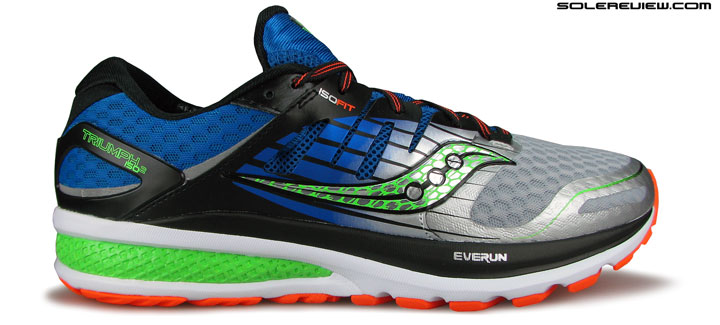
The upper landscape looks very familiar, because this model gets incremental updates, nothing major.
Saucony has tinkered with the new Triumph upper, leading to some improvements in how the shoe fits. Regardless, the new ISOFIT upper feels a very familiar place to be in if you’re moving on from the original ISO Triumph.
The most prominent updates are made on the forefoot, and that’s exactly where you’ll feel the difference in fit.
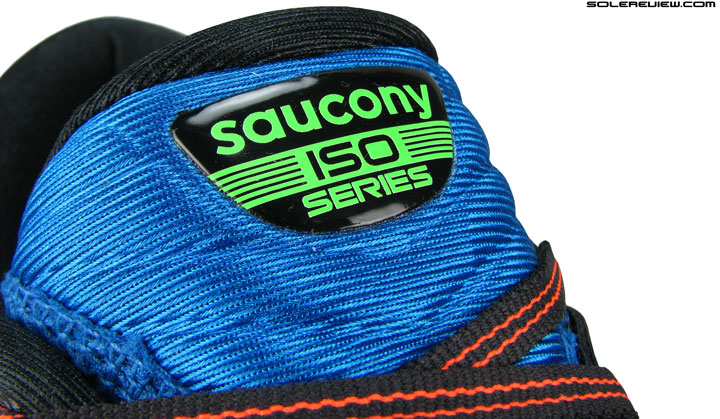
Wonder what does ISO stand for? ISO-lated fit? No, this wasn’t a joke, but an educated guess. Makes sense though, does it not?
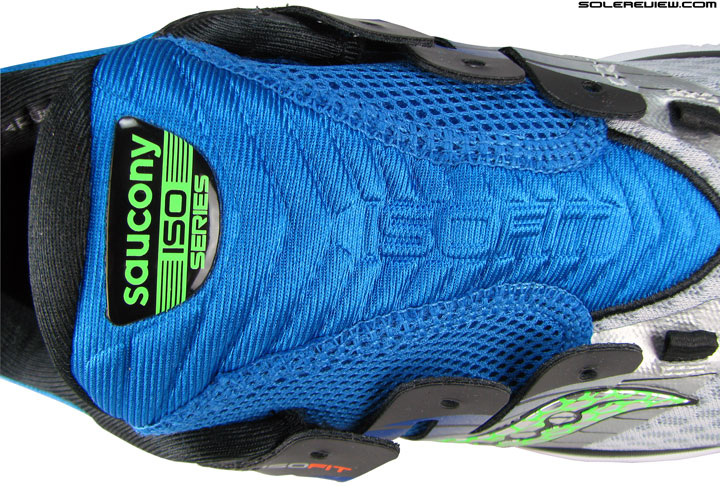
The sleeve and tongue-top design is near-identical to the 2014 Triumph ISO. Molded mesh with a wee bit of padding packed within.
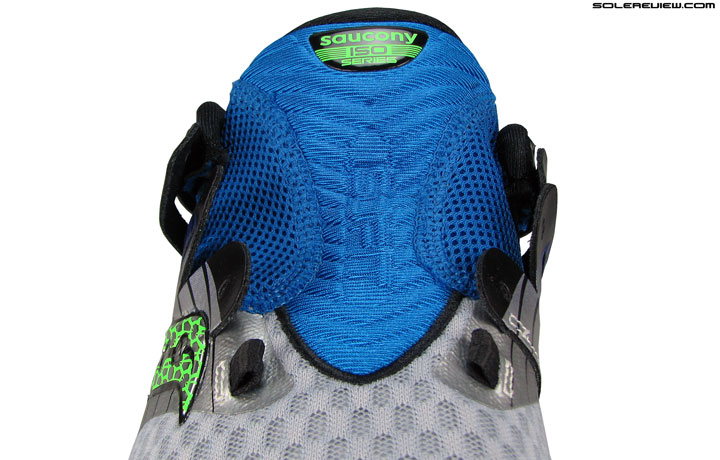
The ISOFIT floating panel when seen from the front. The ‘fingers’ or straps are independent of the midfoot upper. Except for the first row, that is.
The ISOFIT upper design made its debut only last year, so it would be asking too much to expect any major changes. Rather, this time there are only subtle tweaks on what is a carry-forward design base.
So the new Triumph ISO 2 upper feels much like the older design, barring a few updates.
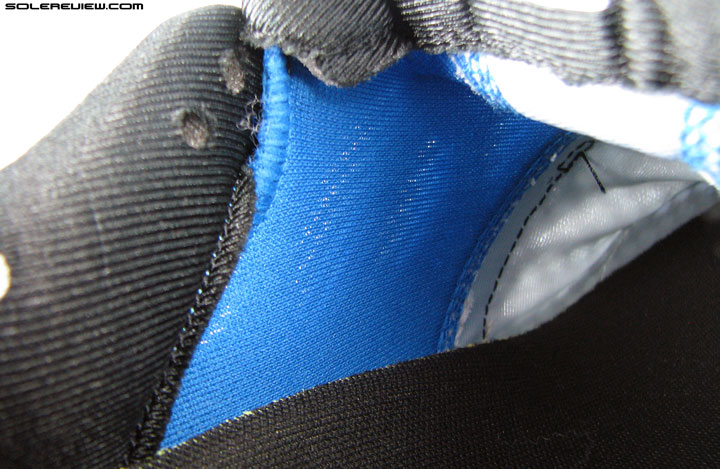
The Triumph ISO has a full sleeve, and not a gusset (half sleeve). Makes for a reassuring midfoot wrap.
What hasn’t changed is the sleeved midfoot construction with a floating midfoot panel (aka the ISOFIT), the identical heel/tongue lining and their quilting levels.
The upper seems to have shed some bulk, because even with the Everun insert, the weight class stays constant. There is just a 8 grams/0.3 oz increase over the 2014 Triumph ISO, which practically amounts to nothing.
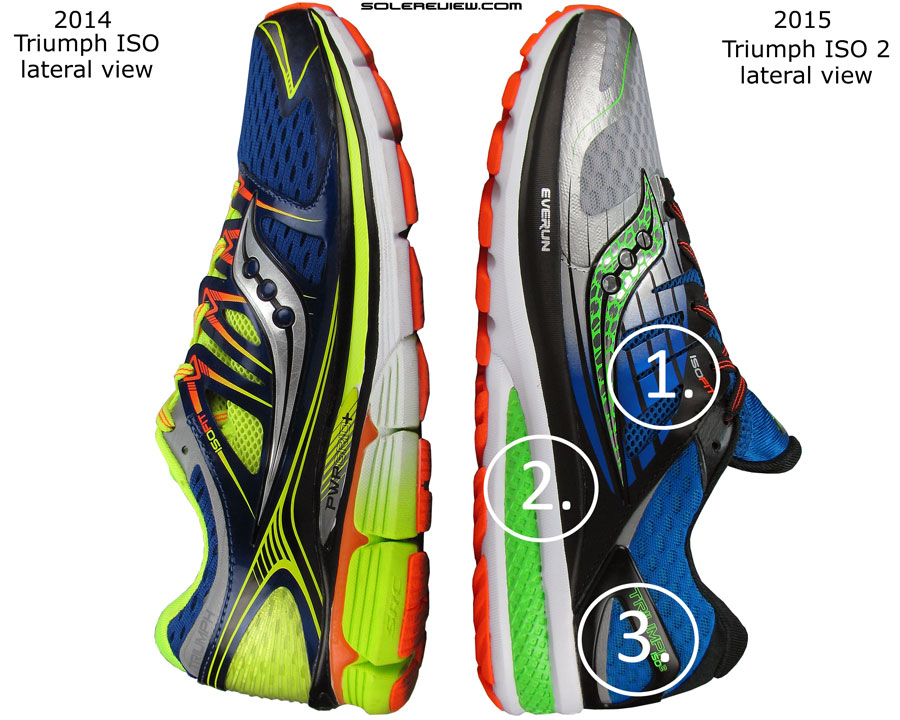
1) Midfoot ISOFIT panels have been made smaller 2) The Everun insert does not make the heel softer 3) Reduced reflectivity
Most of the structural change happens on the ISOFIT midfoot panel, which is shorter than before. The picture here clearly demonstrates the difference. When compared side-by-side, one can see the reduced coverage of the synthetic leather component.
This year, the ISOFIT side panel starts much later on the forefoot, and the rear-foot portion which was synthetic leather before has now been replaced with mesh.
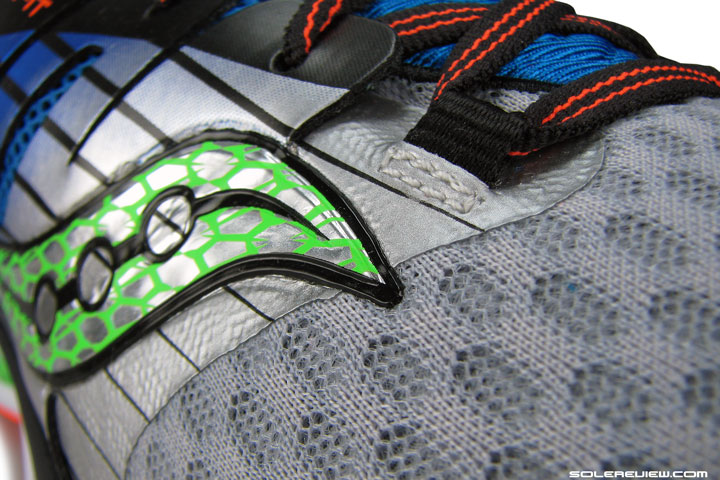
The first row of lacing is free of ISOFIT’s cinching system. That means the elimination of top-down pressure felt on the original Triumph ISO.
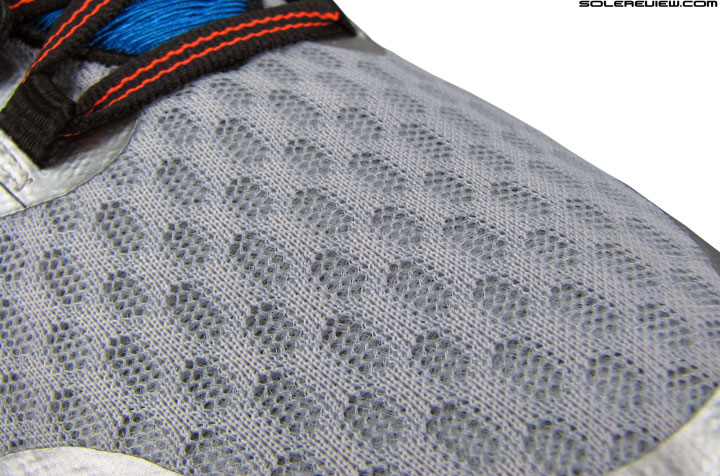
The forefoot is more relaxed that the earlier version. Mind you, the cinching of the first lacing row tends to bunch up the pictured spacer mesh.
If the fit quality of the Triumph ISO 2 has changed, that’s almost entirely owing to the ISOFIT panel update. Shortening of the synthetic area means a larger area of exposed mesh on either sides of the forefoot.
It also equates to the first row of lacing working independently of the ISOFIT clutching system. The first lacing row is mounted directly on the mesh upper by means of speed loops which does not extend inside the upper.
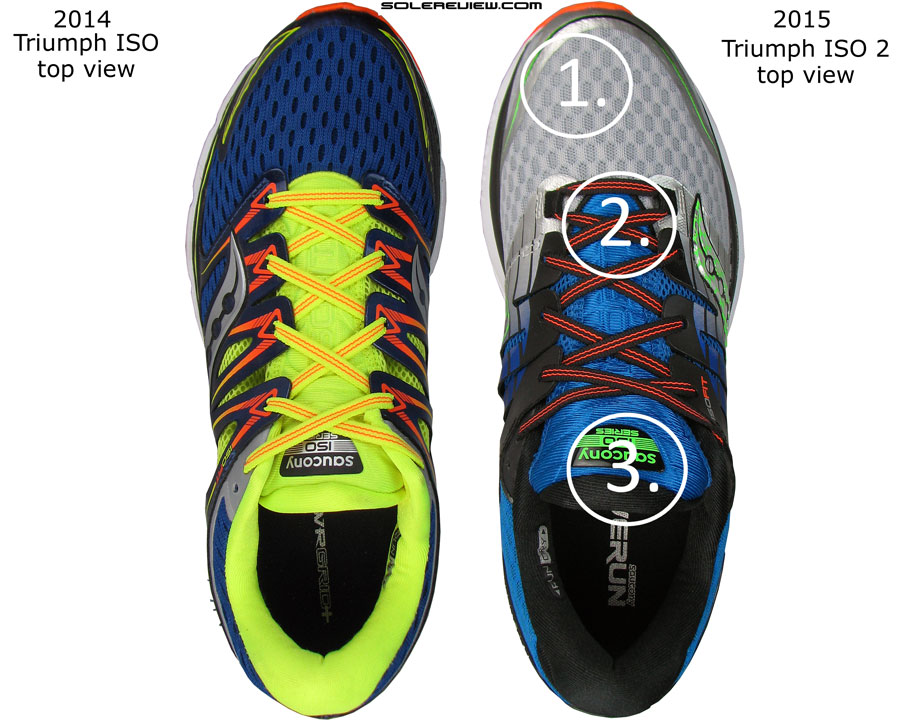
1) More toe-box room 2) Lower lacing pressure, but forefoot mesh is prone to bunching 3) Slightly longer tongue
This eases off the lacing pressure under the first and second row of eyelets. The Triumph ISO 2’s tongue is ditto as previous year’s; padded flap near the ankle and molded over the midfoot.
The gap between lacing is the same, and so are the semi-elastic laces seen on other Saucony models.
So rather than the tongue padding or lacing width, it is the downsizing of the floating ISOFIT wrap and the position of the first two rows of eyelets which does the trick.

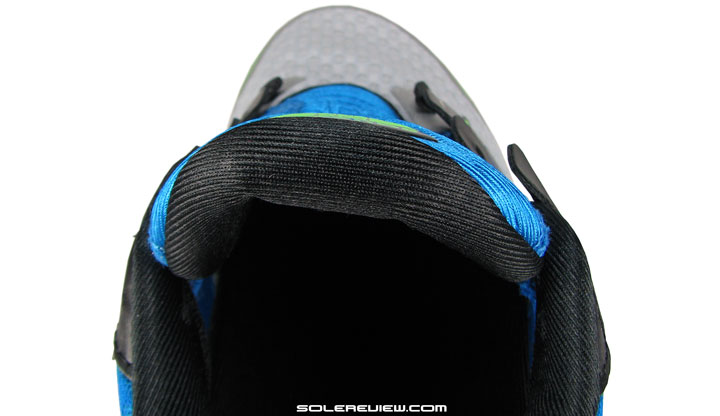
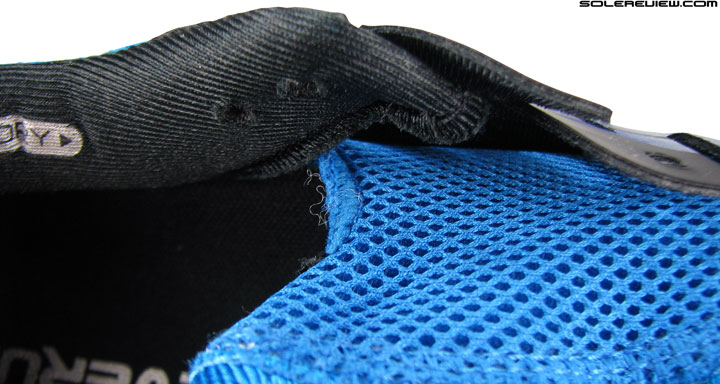
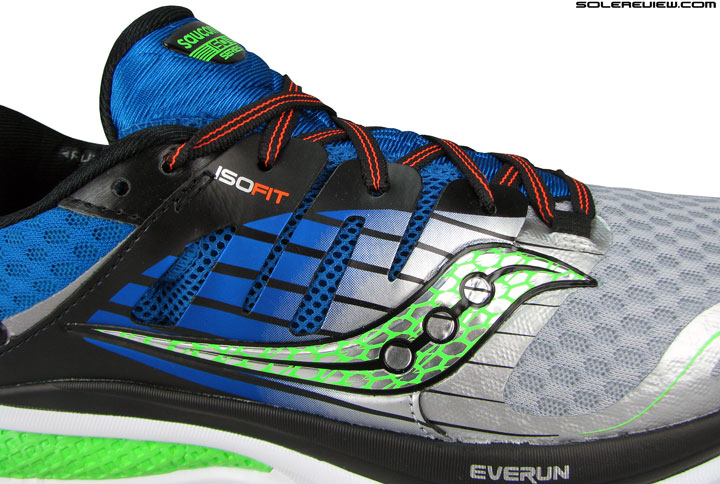
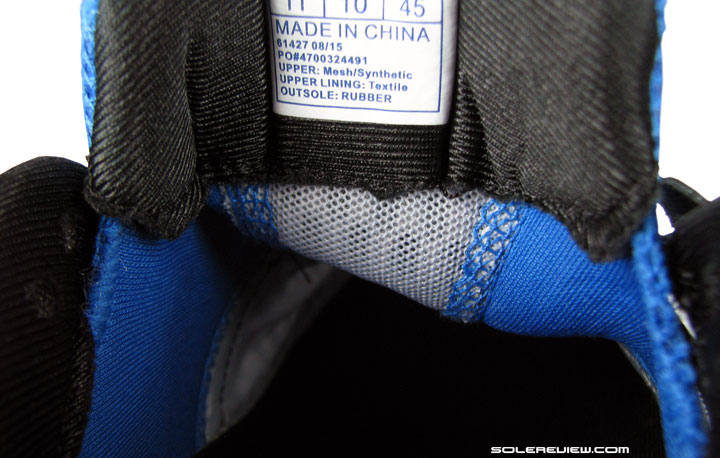
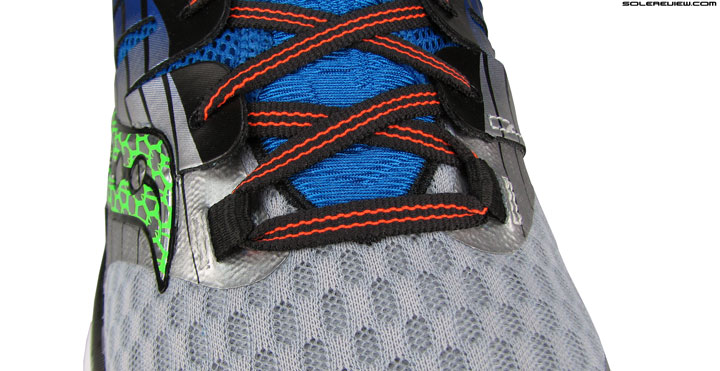
23 comments
I´m just at page 1 of the review but want to say: “Happy new year :)” to you! I wish you all the best for 2016 and may you be able to continue your great work!
Thank you so much! Have a wonderful new year!
A lot of people say the ISO 1 was better. If this is firmer then I would tend to agree since it’s basically the same shoe with different tech. Saucony, stick to your guns already. Bring the old school raquet grid back please.
People who like a softer ride will find the ISO 1 better for sure.
Having ran a lot in the first Triumph ISO I was looking forward to the release of the ISO 2. As soon as my local running store had them I purchased a new pair only to be disappointed by the firmer ride. While the upper on the ISO 2 is an improvement, the ride for me was a let down. Some are going to like the more responsive ride, especially those who’ve never ran in the original. I think many who were so pleased with the original (myself included) are going to be put off by the change in the ride. I can definitely tell a difference in the ride. To me it’s not near as forgiving. And for some reason my feet go numb while running in these. I’ll never understand running shoe companies. Saucony already had shoes you could buy for responsiveness, why not just let the Triumph be their soft, highly cushioned shoe for those of us who like that feel?
Thank you for the feedback, Mark. Runners will be divided on the ISO 2 for sure; softness vs. responsiveness. And agree, the Ride is more softer than the Triumph, an aspect we called out in our Triumph review last year.
Why exactly would you get your hands on boost foam and water it down like this? The stuff is amazing when used properly.
Beats us. Budget issues? Saucony is part of a smaller parent company.
I enjoyed the Triumph ISO 1 for close to 300 miles, and purchased the ISO 2 as soon as it came out. I enjoy roomy toe boxes, being an almost but not quite wide footed individual. With the ISO 2, it always felt “less roomy” in the toe box than the ISO 1, but figured it was just the new vs. worn down feeling. Got about 10 training runs in the 2’s and used them for a half ironman. First black toenail in 2 years. I don’t want to blame the toenail on the shoe, but it seems the common opinion is that black toe nail equates directly to lack of space up front (?). I have moved up a half size and this seems to provide more adequate room, but now the upper bunches on me when laces are tied :(.
As for the way they feel to me, definitely firmer. I don’t relate firm to bad; however, for the first couple of miles my feet feel “tired”, after a couple of miles I loose that feeling and I’m apparently good for as many miles as I want to put in.
I’m currently battling some tendinitis, apparently from to quick of an increase in miles, but have wondered about finding a bit more stability in otherwise neutral shoes. I have had the chance to try on the Transcend 3, and was pleasantly surprised with what seems like quite a roomy toe box. I think I will give those a try. Any other suggestions with regard to more stability, toe box roominess, and cushioned long mileage shoes are very welcomed. The doctor I’m seeing for the tendinitis has the opinion that I’m on the correct (neutral) type of shoe; the finding a bit more stability is of my own creation.
Appreciate your detailed insight, Paul. We find it interesting that your comment mentions the ISO 2 to have a smaller toe-box, we thought the reverse to be true! Just shows how feedback varies depending on the individual.
We haven’t tried the Brooks Transcend 3, but your comment about its roomy toe-box has piqued our interest. We found the Transcend 1 and 2 to have a tight upper.
As regards to your requirement for stable shoes with a roomy toe-box, we would recommend the Mizuno Wave Inspire 11 or 12, Mizuno Wave Rider 19 (neutral but stable), the Hoka One One Constant and finally the Nike Air Zoom Odyssey.
curious… the everun insole plus some thin insole (the first one that comes to mind is the adiZero insoles)… can that combo replace a traditional insole of a shoe that lacks some ooomphh in the cushioning department?
As a first layer of cushioning under the foot, the Triumph ISO 2 scores well over traditional insoles.
The comments/Q&A thread will be closed till January 17, 2016. Any inconvenience is regretted. Premium access members can continue to use their dedicated comment section, which will be open.
I recently began running a year ago (28 yrs old). I’ve ran one marathon, and six half marathons. In training for six back to back half marathons, I developed a stress fracture of my inferior pubic ramus. My last half marathon I finished at 1:29 (PR). I have about six-eight weeks of recovery at the moment, and have been trying to do research on whether or not the stress fracture may have been in any way related to the shoes I was training in. Leading up to the stress fracture I jumped from a four day a week running plan to a six day a week plan. Five days consisted of running in the Adidas energy boost. One day a week would be a speed run in the Adidas adios boost 2 or 3 and I was racing in the Adios Boost 2 & 3. Mentally, the stress fracture is challenging. It is hard to know exactly what aided in the cause of the fracture. Could the shoes have been an issue? Upon recovery I was interested in swapping possibly away from Adidas and into something else, but not sure if this would help prevent the issue moving into the future. I think the rapid increase in running and pace caused the fracture, and back to back races…. but is there any recommendation you have as far as the shoes? Are minimalist shoes better at avoiding stress fractures? The research is mixed. Would it be safe or recommended to move to a different shoe? Any suggestions? Thanks.
It is just our opinion, but we think the likely cause to be the accelerated rate of training/mileage.
The research is mixed because there is no conclusive evidence that a softer (or for that matter a harder) shoe decreases or increases impact forces in isolation.
If you want to feel reassured with regards to your footwear choice, then perhaps a Hoka One One (Clifton, Bondi 4) could be an option. It is unlikely that they will reduce the impact forces, but they might end up feeling more comfortable over greater distance.
Thanks for the reply. I believe my main concern was how legit the research was regarding min vs. Max in relation to impact forces on bone vs. muscle/tendon. From what I’ve been able to find it’s pretty much as you’ve said. When I’m able to get back into the training I may try the Cliftons out. Attempting to break into the 5 minute pace mark for a full marathon, but recurrence of stress factor of course a worry and making sure all bases are covered. I also feel the fx was a result of rapid increase in training and pace and not the shoes. Thanks for the awesome reliable reviews and the reply.
All research has a rationale, but there are just too many variables involved to have a consistent set of control conditions. Hence the mixed findings.
Recover soon, and would to hear what eventually worked for you comfort-wise!
Seem to be recovering on time. Hopefully only a week or two to go. Went to try on the Clifton’s per the recommendation. Actually enjoyed the feel of the Clifton 2, but torn between those and the Hoka Vanquish 2. A little heavier, but appear to have great responsiveness (not able to test on treadmill yet). Would love to know if you were planning on reviewing those in the near future, or if you had any early impressions. With the Hoka Tracer coming out soon, I may just make the brand swap to Hoka and hope for the best
Thank you for sharing your feedback.
The Vanquish 2? No miles in them, and unfortunately no plans to review them.
(its kind of general question) Let me start with obvious thing, your reviews are awesome! :)
My question is, do you consider price while reviewing shoes? Like, $120 Ride 7 is rated a lot higher than $160 Triumph ISO 2, in your opinion, is Ride 7 better shoe than ISO 2 or your rating is relative based on their price?
In other words, if ISO 2 was $120, would you still rate it lower than Ride 7?
Correct, there is some price weightage, but not significant. Primary considerations are fit, stability and transition quality. The Ride 7 is a better shoe than the ISO.
Great, thanks!
It will be interesting if you review cheaper shoes, like $60 Saucony Cohesion 8, 9. Saw some good reviews for it in other sites.
Thanks for the suggestion. But it is unlikely we’ll be reviewing them – no budget.
Comments are closed.